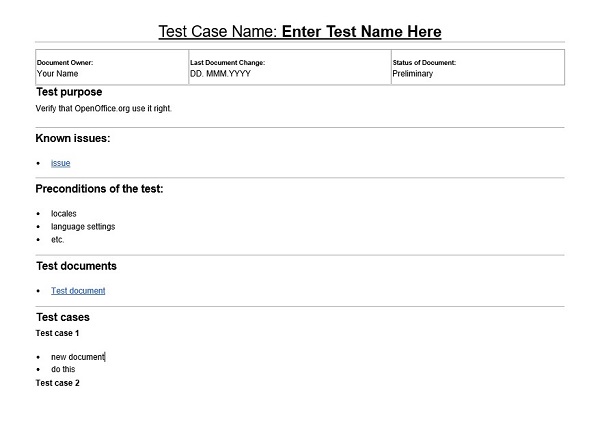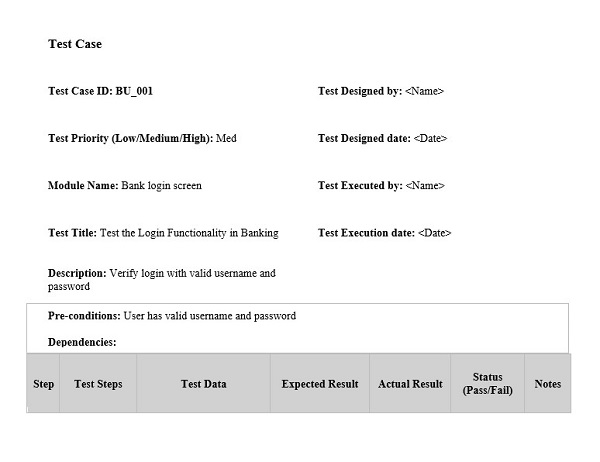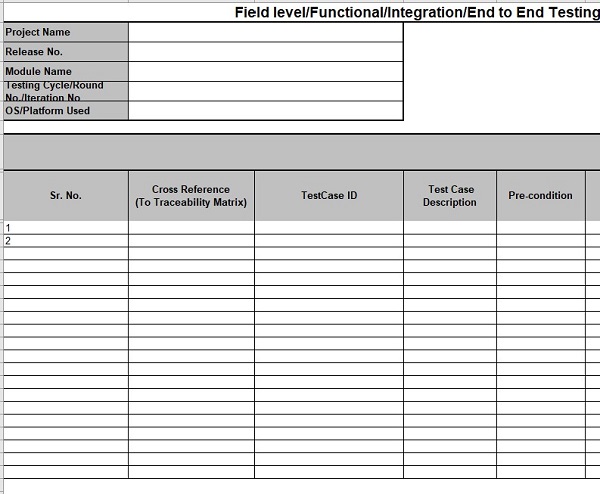Test Case Template in Software Testing – Test case templates are indispensable tools in software testing that guide the testing process, ensuring it is systematic, comprehensive, and effective.
You need to make a test case to ensure whether your product is ready to launch. You don’t have to create the test case manually because it takes time. Instead of creating it manually, you can download a template.
Type of test case
Before downloading the template, let’s determine the type you can use.
Test Case ID Template
A test case ID is used to manage your test well. You can use the test case ID to note the detail to prevent repeatedly testing the product in the same method. Another benefit of using this form is that you will also have complete documents about the test. You can mark the ID to know which cases work and which do not. To make it easy, you can download the test ID template. This kind of template is easy to find, and you can download it for free.
Test Scenario Template
You need this test case template to document important information about the testing process, including the test steps. The main function of the template is to get valid data.
It is difficult to create if you do it manually because you have to avoid any unimportant or unnecessary things on the test scenario form. The faster option is to download the test scenario template because you will have the most important point to fill in. Ultimately, you can finish the report or form faster and easier.
Test Steps Template
You also need to record the steps you have done during the testing. It is only possible to memorize some of the steps. The best solution is to use a test steps template.
This test case template consists of the list you have to fill that is directed to the steps. As a result, you will have more detailed information about your testing. You can use the template to write down steps while trying new software, inserting data, or submitting data.
Test Data Template
The purpose of testing is to complete your objectives. In this case, you need to make a report to measure your achievement to fill the objectives.
Instead of spending time creating the template manually, you can download the test data template from specific reputable websites for free. Later, you can get the best sample which closer to the objectives.
Now, you are learning about the type of test case template and the function of those templates. Use the template so you can do your jobs effectively.
Creating a Test Case: A Step-by-Step Guide
It is a systematic process that involves careful planning and meticulous documentation.
Using a template can simplify this process, ensuring all necessary information is included and organized coherently.
Here is a step-by-step guide on how to make it using these templates:
- Identify Test Case ID: Start by giving a special identifier to the test case using the ID Template. This ID should be concise yet descriptive, providing a quick overview of the test case.
- Define Test Scenario: Next, utilize the Test Scenario Template to describe the situations beneath which the software will be sampled. It should be a high-level description of what the test aims to reach.
- Outline Test Steps: Tracing the steps to run using the Test Steps Template. It should include the actions to be completed, the order of these actions, and any specific needs to be completed.
- Specify Test Data: Finally, use the Test Data Template to specify the data that will be utilized to try the software. It should have good and null data to test the software’s operation and robustness.
- Review and Refine: Once drafted, review it for completeness and accuracy. Ensure all necessary information is included and the test case is clear and easily comprehended. Refine the test case as necessary, adding or removing information to enhance its effectiveness.
- By following these steps and using the appropriate templates, testers can ensure their test cases are comprehensive, systematic, and effective. It, in turn, can enhance the quality of the software and ensure that it meets the needs and expectations of its users.
The Role of Test Case Template in Software Testing

It plays a pivotal role in the area of software Trials. They serve as a structured guide for testers, ensuring that every software element is thoroughly examined. Here’s how these templates contribute to the efficiency and effectiveness of the testing process:
- Standardization: It provides a standardized structure for recording. It provides consistency across all test cases, creating them easier to comprehend and manage. It also facilitates communication among team members, as everyone is familiar with the format and knows where to find specific information.
- Efficiency: Templates provide a clear structure and save testers time planning and recording. They eliminate the need to start from scratch for each test case, allowing testers to focus more on the actual testing.
- Thoroughness: It ensures that all necessary information is included separately. It prompts testers to consider various software factors, such as different scenarios, steps, and data. It ensures a thorough examination of the software, reducing the risk of missing critical tests.
- Traceability: It facilitates traceability in the testing procedure. Documenting all test cases in a standardized structure constructs it more straightforward to track the testing strategy and identify any issues or gaps.
- Quality Assurance: Ultimately, using templates contributes to the rate of the software. By ensuring thorough and systematic testing, these templates assist in determining and rectifying any issues or flaws in the software, ensuring that it meets the needed standards and functions as desired.
Tips for Effective Test Case Creation
Here are some advice and the best techniques for developing useful test cases:
Write Precise and Brief Test Steps: It should be obvious and straightforward. They should be easy to comprehend and follow, even for someone unfamiliar with the software. Use technical vocabulary sparingly, and ensure each step is necessary for the test.
Define Test Data: It is an essential component. It’s the input that you will utilize the software. Be sure to explain your trial data clearly and ensure that it covers various scenarios. It could include normal, boundary, and erroneous data.
Document Expected and Real Results: Document the desired outcome per test stage. It is what you expect to occur when the test phase is completed. After completing the test step, document the exact outcome. It is what occurred when you completed the test stage. Comparing the desired and real results will assist you in determining if the test enacted or fallen.
Keep It Simple: A useful test case is simple and easy to comprehend. To create your test case easily enough to make it easier to manage and understand. If a test case evolves too complex, consider breaking it into multiple smaller ones.
Check and Update: Regularly check to confirm they are still relevant and update them as necessary. It will ensure that your test cases continue providing value and trying the software.
You can complete practical test cases that thoroughly test the software and assist in identifying potential issues or defects. Remember, the goal is to test the software, not prove it works. So, feel free to complete test cases examining the software and its limits.
Common Mistakes to Avoid in Test Case Creation
Recognizing and avoiding these errors can improve the effectiveness. Here are some of the most typical errors and how to avoid them:
- Overcomplicating Test Steps: One of the typical errors is overcomplicating the test steps. Test steps should be clear, concise, and easy to comprehend. More complex test steps can lead to clarity and problems during the proses. To avoid this, keep your test steps simple. If a test case becomes too complex, consider breaking it into smaller, more manageable ones.
- Not Defining Test Data Properly: Test data is crucial to a test case. However, testers often need to define their test data properly. It can guide to insufficient testing and missed flaws. To avoid this, ensure that your test data is well-defined and covers a scenario. It includes normal, boundary, and erroneous data.
- Failing to Document Results Accurately: Accurate documentation of the expected and actual results is essential for determining if a test has passed or failed. However, testers often need to document their results accurately. It can guide to confusion and incorrect conclusions about the software’s rate. To avoid this, always document your desired and actual effects clearly and accurately.
- Ignoring Negative Test Cases: Testers often focus on positive test cases – scenarios where the software is desired to work correctly. However, ignoring negative test cases – scenarios where the software should fail – is a common mistake. Negative test cases are important for identifying how the software takes mistakes or unexpected inputs.
- Not Checking and Updatings: Software evolves, and your test cases should too. Failing to check and update regularly is a common mistake. It can show outdated that no longer provide value. To avoid this, regularly review your test cases to confirm they are always relevant and update them as necessary.
By avoiding these errors, you can create more effective test cases that test the software and help identify potential issues or defects.
Test Case Templates
These templates provide a structured layout for recording test cases and can be customized to fit your testing needs.
The templates cover a test case’s important parts, including the test case ID, test scenario, test steps, test data, expected results, and actual results. They also provide space for recording preconditions, postconditions, and notes or comments.
These templates can be a valuable starting point for creating your test cases. They can save you time and ensure you pay attention to all important details. However, remember that every software project is unique, and the templates should be adapted as necessary to fit your specific testing requirements.
The Importance of Regularly Updating
It should be updated whenever there are modifications to the software’s functionality, user interface, or performance requirements. It provides that remains relevant and continues to provide value.
Additionally, It should be reviewed and updated to reflect any changes in the software’s operating conditions, such as updates to the operating method or browser.
It is not just about adding new ones. It’s also about removing or modifying existing test cases that are no longer relevant or effective. It helps maintain the testing process’s efficiency and ensures that resources are not wasted on unnecessary tests.
Here are some tips for updating:
- Keep track of software changes: Stay in close communication with the development team to stay informed about any modifications.
- Review regularly: Schedule regular inspections of your test cases to determine any that need to be updated.
- Prioritize updates: If help is limited, prioritize updating that protects critical functionality or high-risk areas of the software.
- Document updates: Whenever you update, document the modifications. It helps to maintain a record of the test case’s evolution and provides valuable context for future updates.
Examples of Test Cases
Understanding how to create effective can be made easier with real-life examples. Here are a few scenarios that illustrate how these templates can be used in practice:
Testing New Software Features
When a new feature is added to a software application, creating test cases validating its functionality is crucial.
For example, if a new payment method is added to an e-commerce website, It could be created to verify that it works correctly. The test steps include:
- Navigating the payment page.
- Selecting the new payment method.
- Entering valid payment information.
- Confirming the payment.
The expected result would be that the payment is processed successfully, and the actual result would be documented after the test is executed.
Troubleshooting Existing Issues
It can also replicate and troubleshoot user-reported issues. For instance, if users report that an application crashes when they perform a specific action, It could be created to replicate this issue. The test steps detail the actions leading to the crash, and the expected result is that the application does not crash. If the application does crash, this would be documented as the actual result, providing clear evidence of the issue.
Regression Testing
Whenever changes are made to the software, it’s important to perform regression testing to ensure that existing functionality has not been adversely affected.
For example, if a bug fix is implemented, It could be created to verify that it works and does not introduce new issues. The test steps would involve replicating the original bug, applying the fix, and then checking that the bug no longer occurs. The expected result would be that the bug is resolved, and the actual result would be documented after the test is executed.
These examples illustrate how test cases can validate new features, troubleshoot issues, and perform regression testing. By following the templates and adapting them to your specific needs, you can create effective test cases that contribute to the quality and reliability of your software.

The content creator team at calipsotree.com is dedicated to making topics accessible to everyone, with over 9 years of experience in writing and breaking down complex concepts into easy-to-understand articles that answer readers’ financial questions.

















